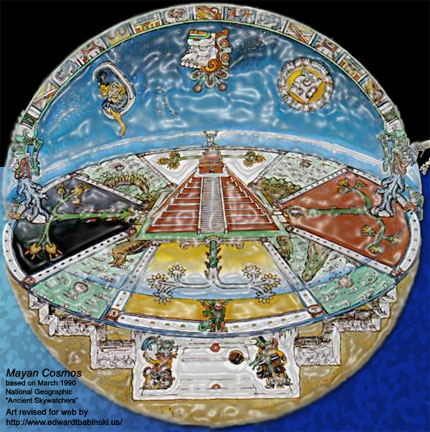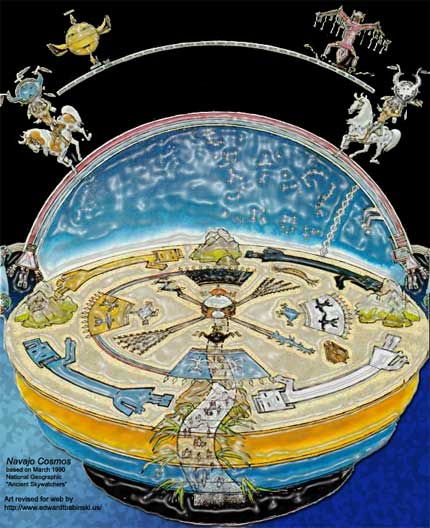 A simulation of the structure of the universe- foamy, web like
A simulation of the structure of the universe- foamy, web likehttp://neutrino.aquaphoenix.com/un-esa/universe/universe-chapter2.html

The king of the Inca believed he was the son of the sun, and the cosmos was centered on the Sun Temple at Cuzco, Peru. In one origin myth the Inca people came from three caves; in another myth they arose from Lake Titicaca. The straight red lines are ceques, symbolizing connections to sacred places. The major ceques formed borders of the four-quarted Inca world. The Milky Way blended into the underworld and brought dark, fertile mud to the sky upon its return, which formed patches that resemble animals, like the snake (at top) toad, tinamou bird, mother and baby llama, fox and a second tinamou. The sun is portrayed as a male god, and the moon as a female.
Original paintings by Ken Dallison, Principal Consultants; Original Article by John B. Carlson, Center for Archaeoastronomy (Maya); Trudy Griffen-Pierce, University of Arizona (Navajo); Gary Urton, Colgate University (Inca).
Indra's Net
'As the threads of Indra's net bind the gems to the net so do our physical bodies bind our minds and other physical entities bind other systems to the universe. Through the threads we reach each other, passing information across the expanses of space. '

FAR AWAY IN THE HEAVENLY ABODE OF THE GREAT GOD INDRA, THERE IS A WONDERFUL NET WHICH HAS BEEN HUNG BY SOME CUNNING ARTIFICER IN SUCH A MANNER THAT IT STRETCHES OUT INDEFINITELY IN ALL DIRECTIONS. IN ACCORDANCE WITH THE EXTRAVAGANT TASTES OF DEITIES, THE ARTIFICER HAS HUNG A SINGLE GLITTERING JEWEL AT THE NET'S EVERY NODE, AND SINCE THE NET ITSELF IS INFINITE IN DIMENSION, THE JEWELS ARE INFINITE IN NUMBER. THERE HANG THE JEWELS, GLITTERING LIKE STARS OF THE FIRST MAGNITUDE, A WONDERFUL SIGHT TO BEHOLD. IF WE NOW ARBITRARILY SELECT ONE OF THESE JEWELS FOR INSPECTION AND LOOK CLOSELY AT IT, WE WILL DISCOVER THAT IN ITS POLISHED SURFACE THERE ARE REFLECTED ALL THE OTHER JEWELS IN THE NET, INFINITE IN NUMBER. NOT ONLY THAT, BUT EACH OF THE JEWELS REFLECTED IN THIS ONE JEWEL IS ALSO REFLECTING ALL THE OTHER JEWELS, SO THAT THE PROCESS OF REFLECTION IS INFINITE THE AVATAMSAKA SUTRA FRANCIS H. COOK: HUA-YEN BUDDHISM : THE JEWEL NET OF INDRA 1977 This graphic and metaphor for The Mystery of Love is the enduring Hindu cosmic ideal of the Net of Indra, also called the Net of Gems. It communicates that all loves are reflected in every other love and that the universe is an interconnected whole, which can be experienced as an interdependent universe or a universe of love. The story goes that Indra (the King of all Hindu Gods) commissioned a highly skilled craftsman to create a large net consisting solely of polished gems and finely woven silk threads. The jewels were placed at the intersections of the net, and in each one could be seen every other jewel. For Hindus the net described a universe that was entirely interconnected—a cosmology that implies the oneness of being. When related to love, each and every intersection represents a moment of connection between separate forces, be it man and woman; human and God; the individual and nature; parent and child. The jewel is love and so—in the net—every love is reflected in every other love. The net of Indra represents how different forms of love are held together in a universe held together by love. The metaphor is even more powerful than that. For the Net of Indra does not actually exist. It is an idea, an illusion, a myth or a story that humans imagine to help them understand the universe. All of us live by such stories, to explain, to connect to, to give meaning to the experience of being alive, whether about the birth of the universe or the feelings we perceive others have for us—or we have for Others. Love is such a story; rather, love is many such stories. Bhumandala  The region within the shell is called the Brahmanda, or "Brahma egg." It contains an earth disk or plane—called Bhu-mandala—that divides it into an upper, heavenly half and a subterranean half, filled with water. Bhu-mandala is divided into a series of geographic features, traditionally called dvipas, or "islands," varshas, or "regions," and oceans. In the center of Bhu-mandala is the circular "island" of Jambudvipa, with nine varsha subdivisions. These include Bharata-varsha, which can be understood in one sense as India and in another as the total area inhabited by human beings. In the center of Jambudvipa stands the cone-shaped Sumeru Mountain, which represents the world axis and is surmounted by the city of Brahma, the universal creator. Similarities between the Bhumandala model and the modern cosmological model: - Both suggest that the earth isn't flat -the disk of Bhu-mandala corresponds in some detail to the solar system - If we compare Bhu-mandala with the Earth, the solar system out to Saturn, and the Milky Way galaxy, Bhu-mandala matches the solar system closely, while radically differing in size from Earth and the galaxy. Furthermore, the structures of Bhu-mandala correspond with the planetary orbits of the solar system |
http://absolutetruth.in/wiki/Bhagavatha_cosmology
The universe of the Maya were centered on a tiered pyramid, and rest upon a crocodillian cosmic sea. Each quarter of the earth was associated with color, and the center of the earth was a "fifth direction". Four sacred beings supported the dome of heaven, illustrated as a two-headed dragon, which had a body as a sky band of celestial symbols. It is arched over the moon goddess, who is holding the rabbit discerned in the moon's face, and a skeletal Venus, and the sun god. Pleides, is a star cluster and a rattlesnake tail. Creation of both sun and probably the planet Venus was explained with a legend of Hero twins who vied with the Lords of Death during a series of ball games. The victorious twins became these celestial bodies.
The Navajo Cosmos was portrayed as a sand painting, the world view of Diné-- "the people," as Navajo referred to themselves, centering on the family hogan. The first hogan was built in the place the ancestors emerged, and travelled through three previous words before arising from a hollow reed into this "glittering" place. The four quarters of the world is characterized with color, holy mountain, time of day, and a sacred person. The rainbow god is a guardian, and the sky sparkles with constellations (the Milky Way) symbolized by a band of crosses. Young warriors carry the blue sun and white moon. Beyond the sky is a land in which the Big Wind (yellow) and Big Thunder rule.
The king of the Inca believed he was the son of the sun, and the cosmos was centered on the Sun Temple at Cuzco, Peru. In one origin myth the Inca people came from three caves; in another myth they arose from Lake Titicaca. The straight red lines are ceques, symbolizing connections to sacred places. The major ceques formed borders of the four-quarted Inca world. The Milky Way blended into the underworld and brought dark, fertile mud to the sky upon its return, which formed patches that resemble animals, like the snake (at top) toad, tinamou bird, mother and baby llama, fox and a second tinamou. The sun is portrayed as a male god, and the moon as a female.
Original paintings by Ken Dallison, Principal Consultants; Original Article by John B. Carlson, Center for Archaeoastronomy (Maya); Trudy Griffen-Pierce, University of Arizona (Navajo); Gary Urton, Colgate University (Inca).





No comments:
Post a Comment